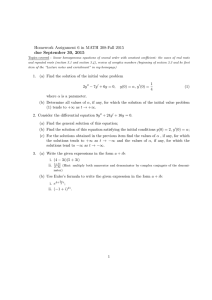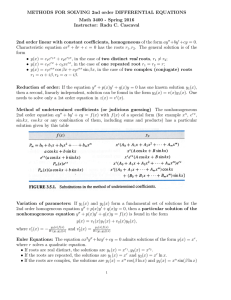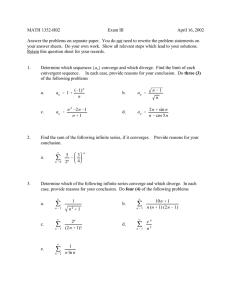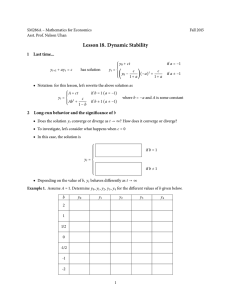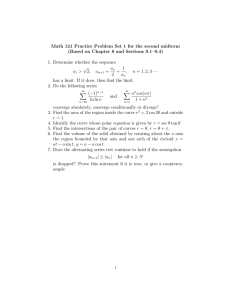Class 17 Complex Factors Practice
advertisement
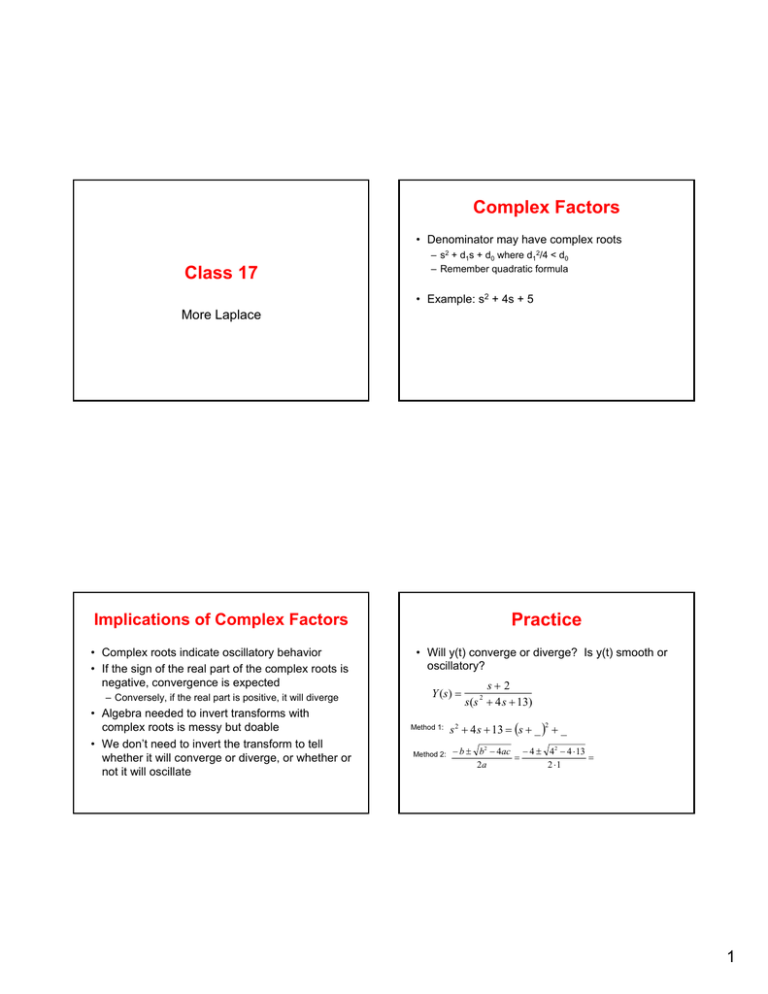
Complex Factors
• Denominator may have complex roots
Class 17
– s2 + d1s + d0 where d12/4 < d0
– Remember quadratic formula
• Example: s2 + 4s + 5
More Laplace
Practice
Implications of Complex Factors
• Complex roots indicate oscillatory behavior
• If the sign of the real part of the complex roots is
negative, convergence is expected
– Conversely, if the real part is positive, it will diverge
• Algebra needed to invert transforms with
complex roots is messy but doable
• We don’t need to invert the transform to tell
whether it will converge or diverge, or whether or
not it will oscillate
• Will y(t) converge or diverge? Is y(t) smooth or
oscillatory?
Y (s) =
Method 1:
Method 2:
s+ 2
2
s(s + 4s + 13)
s 2 + 4 s + 13 = (s + _ ) + _
2
− b ± b2 − 4ac − 4 ± 42 − 4 ⋅ 13
=
=
2a
2 ⋅1
1
Inverting Transforms with Complex
Roots in the Denominator
• There are at least two different ways to
proceed as described in your text on pp.
48-49.
– Use of complex numbers and Euler's identity
• cos( ωt) =
(e-jωt
+
e-jωt)/2;
sin( ωt) =
(e-jωt
-
e-jωt)/2
– Expansion without using complex numbers,
followed by completing the square to invert
the transform (preferred)
• Example 3.4
• Wanted:
• Find α1:
• To get α2 and α3, clear denominator and
match “like” terms
s + 2 = α1 ( s 2 + 4 s + 5) + s (α 2 s + α 3 ) = (α1 + α 2 ) s 2 + ( 4α1 + α 3 ) s + α1 5
• s2 terms → α1 + α2 = 0, so α2 = -2/5
• s terms → 4 α1 + α3 = 1, so α3 = -3/5
Y (s ) =
Complete the square
Put into proper form for inversion
s + 4 s + 5 = ( s + b) + w
2
Example
s+2
α
α s + α3
Y (s ) =
= 1+ 2
s( s2 + 4s + 5) s s2 + 4s + 5
2
b = (coefficient in front of s term)/2 = 4/2 = 2
b2 + w2 = 5 = 4 + w2, so w = 1
L{e −bt cos(ωt )} =
2
• How?
• Knowing b, find w
Need to Get Form in Laplace Table
s+b
(s + b )2 + ω 2
− 25 s − 53
( s + 2) 2 + 1
L{e −bt sin (ωt )} =
ω
(s + b )2 + ω 2
Has both an s and a number on the top
− 25 s − 35
− 2 (s + 2) + 15
⎡ (s + 2) ⎤ 1 ⎡
1
⎤
= 5
= − 2 5⎢
+
2
2
2
2
(s + 2) + 1
(s + 2) + 1
⎣ (s + 2) + 1⎦⎥ 5 ⎣⎢ (s + 2) + 1⎦⎥
Finally:
Y (s) =
2 2 ⎡ (s + 2) ⎤ 1 ⎡
1
⎤
− 5⎢
+ 5⎢
2
2
5s
⎣ (s + 2) + 1 ⎥⎦
⎣ (s + 2) + 1⎥⎦
and inverting y (t ) =
2
Analyze the Equation
y(t) =
2 2 −2t
1 −2t
− e cost + e sin t
5 5
5
One More Practice Problem
Y (s) =
1
s − 4s + 13
2
• e-t terms mean that the system will converge at long time
• sin and cos terms mean permanent oscillations
Whew!!
What if Roots to Denominator Are:
⎡2 + 6i ⎤
⎢2 − 6i ⎥
⎢ −1 ⎥
⎢ −3 ⎥
⎥
⎢
⎣ −2 ⎦
Initial Value
( s + 2)
(s + 3)(s + 4)
3
Time Delay
Final Value
(Fortran File)
(s + 6)
(s + 1)(s + 2 )
Wanted:
– Initial step to 5
– Ramp from 5 to 0 starting at t = 5 and ending
at t = 7
– Final value of 0 after t = 7
Example
6
5
y(t)
4
3
2
1
0
0
2
4
6
8
10
12
time
Time Delay
Example
(Fortran File)
6
5
program ft
fun = 0.0
S1=0.
S2=0.
S3=0.
do 100 t=0.,10.,0.1
if(t.ge.0.0)s1=1.
if(t.ge.5.)s2=1.
if(t.ge.7.)s3=1.
fun=S1*5+(-5/2.)*(t-5.)*S2+5/2.*(t-7.)*S3
print*,t,fun
100 continue
stop
end
y(t)
4
3
2
1
0
0
2
4
6
8
10
12
time
4
